What parts of the US have the most to worry about because of climate change? Hm that would be coastal areas, wouldn’t it, especially low-lying, swampy coastal areas, like Louisiana and Florida. And yet…
The state of Florida is the region most susceptible to the effects of global warming in this country, according to scientists. Sea-level rise alone threatens 30 percent of the state’s beaches over the next 85 years.
But you would not know that by talking to officials at the Florida Department of Environmental Protection, the state agency on the front lines of studying and planning for these changes.
DEP officials have been ordered not to use the term “climate change” or “global warming” in any official communications, emails, or reports, according to former DEP employees, consultants, volunteers and records obtained by the Florida Center for Investigative Reporting.
Huh. That’s kind of like telling the Fire Department not to use the terms “fire” or “burn” or “hot.” It’s like telling the health services not to use the terms “bacteria” or “virus” or “infection” or “death.”
“We were told not to use the terms ‘climate change,’ ‘global warming’ or ‘sustainability,’” said Christopher Byrd, an attorney with the DEP’s Office of General Counsel in Tallahassee from 2008 to 2013. “That message was communicated to me and my colleagues by our superiors in the Office of General Counsel.”
Kristina Trotta, another former DEP employee who worked in Miami, said her supervisor told her not to use the terms “climate change” and “global warming” in a 2014 staff meeting. “We were told that we were not allowed to discuss anything that was not a true fact,” she said.
I suppose they’ll be allowed to use the words once Florida is actually under water. That’s a sensible policy. By the same token, we don’t need to fret about falling off great heights until we actually hit bottom. Until then, there’s just no telling what might happen.
This unwritten policy went into effect after Gov. Rick Scott took office in 2011 and appointed Herschel Vinyard Jr. as the DEP’s director, according to former DEP employees. Gov. Scott, who won a second term in November, has repeatedly said he is not convinced that climate change is caused by human activity, despite scientific evidence to the contrary.
Vinyard has since resigned. Neither he nor his successor, Scott Steverson, would comment for this article.
Various flacks said there is no such policy.
But four former DEP employees from offices around the state say the order was well known and distributed verbally statewide.
One former DEP employee who worked in Tallahassee during Scott’s first term in office, and asked not to be identified because of an ongoing business relationship with the department, said staffers were warned that using the terms in reports would bring unwanted attention to their projects.
“We were dealing with the effects and economic impact of climate change, and yet we can’t reference it,” the former employee said.
Climate…progress? Development? Increase? Augmentation? I can think of lots of cheer-up words for it.
Some climate scientists asked for a chance to explain the science to Scott and he said ok, you’ve got 30 minutes. He spent ten of those minutes introducing people, and then sat quietly for the 20 minutes of scientists talking. Then he went back to doing real work.
Scott’s predecessor, Charlie Crist, had been proactive on climate change, forming a statewide task force and convening a national summit in Miami in 2007. But evidence the issue has fallen out of favor during the Scott administration is apparent.
One example is the Florida Oceans and Coastal Council’s Annual Research Plan, put together by DEP and other state agencies. The 2009-2010 report, published the year before Scott was elected, contains 15 references to climate change, including a section titled “Research Priorities — Climate Change.”
In the 2014-15 edition of the report, climate change is only mentioned if it is in the title of a past report or conference. There is one standalone reference to the issue at the end of a sentence that sources say must have slipped by the censors. “It’s a distinct possibility,” said one former DEP employee.
Instead, terms like “climate drivers” and “climate-driven changes” are used.
Climate chocolate sauce, climate flash mobs, climate tight pants.
Christopher Byrd said that he was warned not to use “climate change” and related terms during a 2011 staff meeting shortly after Scott appointed Vinyard as DEP director.
“Deputy General Counsel Larry Morgan was giving us a briefing on what to expect with the new secretary,” Byrd recalled. Morgan gave them “a warning to beware of the words global warming, climate change and sea-level rise, and advised us not to use those words in particular.”
Ah yes sea-level rise – you don’t want to go mentioning that in Florida of all places. God no! The time to mention that is after all the hotels and condos are built, not before. Just issue everyone an inflatable raft and all will be well.
in November 2014, the Coral Reef Conservation Program held a meeting to train volunteers to use a PowerPoint presentation about the threats coral reefs faced. Harper attended the meeting, held at DEP’s Biscayne Bay office in Miami. Doug Young, president of the South Florida Audubon Society and a member of the Broward County Climate Change Task Force, also attended.
Two DEP employees, Ana Zangroniz and Kristina Trotta, showed the presentation to the volunteers and then asked if anyone had a question.
“I told them the biggest problem I have was that there was absolutely no mention of climate change and the affect of climate change on coral reefs,” Young said.
He continued: “The two young women, really good people, said, ‘We are not allowed to show the words, or show any slides that depicted anything related to climate change.’”
Young and Harper said they could not participate if climate change was not mentioned. “The women kept saying, ‘Work with us; we know you are frustrated,’” Harper said.
On Nov. 19, 2014, the DEP’s Zangroniz wrote Harper and Young an email stating she had talked to her manager about their concerns.
“Unfortunately at this time,” she wrote, “we can’t make any alterations or additions to the presentation. … If you do choose to continue as a volunteer, we would have to request that you present the information as is. If you choose to add in an additional presentation or speaker that addresses climate change and coral reefs, there would have to be a very clear split between the two.”
Trotta left her position as a field and administrative assistant in January. She told FCIR that when it came to scrubbing the term “climate change” from projects, she was following orders. Those orders came from Regional Administrator Joanna Walczak during a staff meeting in the summer of 2014.
“We were instructed by our regional administrator that we were no longer allowed to use the terms ‘global warming’ or ‘climate change’ or even ‘sea-level rise,’ ” said Trotta. “Sea-level rise was to be referred to as ‘nuisance flooding.’”
(This is a syndicated post. Read the original at FreeThoughtBlogs.)






